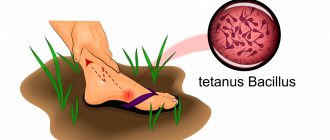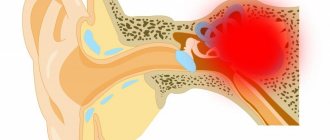What is rabies in dogs and why is it dangerous?
Rabies has a long history and a “strong association” with dogs. The first written account of rabies is contained in the Laws of Eshnunna, dated 1930 BC. e. The report contains not only a diagnosis, but also recommendations that the owner of a dog exhibiting symptoms of rabies should take all possible measures to prevent it from biting anyone.
What is rabies in dogs? It is a viral neuroinvasive disease that causes inflammation in the brain and is usually fatal. Rabies is viral in nature and primarily affects mammals.
During laboratory research, it was discovered that birds can also be infected with the virus. A minor risk group includes cold-blooded animals and insects; they become infected with the virus only unnaturally, if a person has a hand in this process.
Animals with rabies suffer from deterioration of the central nervous system and tend to behave strangely and often aggressively. Inappropriate behavior increases the likelihood that a virus carrier will bite a healthy animal or person, which will lead to transmission of the virus.
In dogs, rabies usually develops in three stages:
- Prodromal or first stage 1–3 days – characterized by behavioral changes.
- The second stage, 3–4 days , is characterized by excitement. It is this stage that is associated with "rabid animal rage" due to the affected dog's tendency to become hyper-reactive to external stimuli and bite anyone and anything that comes close.
- The third stage of 2–3 days is the paralytic stage, which is caused by damage to the neurons of the brain. There are coordination problems and other problems in the central nervous system. The dog cannot walk or does so unnaturally due to paralysis of the hind limb. At this stage, foamy drooling is observed. Further, there are difficulties with swallowing, paralysis of the facial and throat muscles. Death usually occurs due to collapse of the respiratory tract.
Symptoms of infection
Rabies, like any disease, develops according to an individual “scenario”. However, scientists identify five forms:
- Abortive. It manifests itself in the animal’s dramatic recovery. There are only a few such cases known, most of which have no official confirmation.
- Depressed. The first phase of the disease is almost asymptomatic: the owners can only note lethargy. The deterioration occurs sharply and unexpectedly: profuse drooling, coughing and paralysis appear. The animal dies on the third day after symptoms are detected.
- Atypical. It manifests itself in a sluggish illness. The dog shows signs of weakness, lack of appetite, vomiting and diarrhea. This can last up to five months, but will end with the inevitable death of the animal.
- Returnable. It develops according to the principle of “deterioration-improvement”. The pet refuses to eat for several days, is apathetic and lethargic, and then a period of sharp “improvement” begins. After which - a severe attack (their severity will increase over time).
The most common form is “violent”. It goes through several stages:
- Prodromal. At this time, the first symptoms of the disease appear. They can only be noticed by an observant owner who was present when the pet came into contact with a suspicious dog. An infected pet becomes drowsy and apathetic or, conversely, demands attention from its owners. Frequent yawning and a constantly open mouth are also signs of rabies. Stage duration: from one to three days.
- Manic. There is a deterioration in the condition. The dog may crawl under a sofa or closet, avoid light and any contact with water (hydrophobia). She either growls at her owners or seeks attention and affection. The timbre of the voice becomes muffled. Salivation becomes profuse, and the appetite becomes “perverted”: animals lick and swallow inedible objects and garbage. At this time, aggression begins to manifest itself. The dog attacks without hesitation and no longer recognizes its owners. Acute and calm phases alternate: after an attack of aggression, the animal falls on its side, convulses and breathes heavily. Duration of the manic period: from two to five days.
- Paralytic. Convulsions become regular. The dog refuses to eat and does not react to the outside world. Paralysis of the larynx occurs: saliva no longer remains in the throat and flows onto the chest. Then the hind legs become paralyzed. The animal is struggling to crawl to cover. Ultimately, the dog dies from respiratory failure. Duration of the phase: from three to five days.
The lifespan of an animal from the moment of infection depends on the speed of the disease. Most often, the dog suffers from five to seven days. In rare cases - two weeks.
If signs of rabies are detected in an unvaccinated animal, it must be isolated immediately! An infected dog should not be touched; its bite can be fatal.
Dog rabies is an incurable disease. After detecting the first symptoms, you need to come to terms with the idea that recovery is impossible. If a person becomes infected, the disease can be stopped, but only at an early stage!
Incubation period after rabies infection
In the process of large-scale research, it was found that the rabies virus enters the bloodstream through the bite of a virus carrier. The virus spreads from the site of the bite to the brain. Virus cells travel both in the bloodstream and along nerve fibers.
Important! Until the virus concentration in the brain reaches a critical mass and neuronal damage begins, the animal does not appear sick.
The incubation period is the time between the bite and the onset of symptoms. Incubation of the rabies virus can last from several weeks to several months. An animal bite during the incubation period does not carry the risk of infection, since the virus has not yet entered the saliva. At the final stage of the disease, the sick dog produces saliva with a huge amount of virus.
At the stage when the virus cells have multiplied in the brain, almost all animals begin to show the first signs of rabies. Most of which are not obvious. Within 3–5 days, when the virus has destroyed enough neurons, the animal begins to show obvious signs of infection.
In almost all countries, an animal that bites a person or other pet must undergo a mandatory quarantine period.
Some countries require this quarantine to take place at an approved animal control facility, while others allow quarantine at the owner's home.
— How to recognize the symptoms of rabies?
— Often the disease begins with a picture of a common viral infection, namely:
- General weakness;
- Headache;
- Heat.
The patient may notice redness in the bite area and complain of burning and pain.
These symptoms are gradually accompanied by insomnia, irritability, and fear of air and water. When a person with rabies sees water, the esophagus and respiratory muscles begin to spasm, and a large amount of saliva is released.
In the end, delusions, hallucinations, and paralysis develop. The patient dies within 7-8 days from the onset of the first signs of the disease.
Ways of infection with rabies
Routes of infection contacts. All species of mammals are susceptible to infection with the rabies virus, but only a few species in specific areas are the leading vectors.
In Europe and Asia, the most common carriers of the rabies virus are:
- Foxes.
- Bats (predatory).
- Jerzy.
- Raccoons and other canids.
Transmission of the rabies virus occurs when a carrier's infected saliva is transferred to an uninfected animal. The most common way of transmitting the rabies virus is through a bite.
Possible routes of infection are:
- Scratches.
- Contact of contaminated saliva or blood and damaged mucous membranes.
- Contact of contaminated saliva or blood and damaged skin.
Note! recent studies have shown that an animal can become infected with rabies by inhaling gases that are released when the corpse of a virus carrier decomposes. It is unknown whether a person can become infected with rabies in a similar way.
From dog to dog
The rabies virus is transmitted from dog to dog by:
- Bites during fights.
- Courtship - contact of infected saliva with damaged mucous membranes.
The second route of transmission is extremely rare. The fact is that at the moment when the virus accumulates in saliva, the dog develops phobias to sounds, water, light and tactile contacts.
From dog to man
The rabies virus is transmitted from dogs to humans by:
- Bites.
- Contact of saliva and damaged skin or mucous membranes.
How does a dog become infected?
Rabies is a contagious infectious disease that affects the nervous system and manifests itself in fear of hydrophobia and uncontrollable aggression. The second name is rabies. An infected dog becomes dangerous to others before symptoms appear: the virus is contained in saliva, which means it is transmitted through bites.
Transmission of infection occurs when a healthy dog comes into contact with an infected animal. Most often, this requires a bite, but a simple lick will suffice. The virus contained in the host’s saliva enters the body through cracks and scratches. It is also transmitted through other bodily secretions such as vomit and bowel movements.
A special risk group is dogs living in rural areas or near forests. They can catch rabies from foxes, rats, wolves, raccoons, stray dogs and cats. Rabies affects all carnivorous predators, so even squirrels or hedgehogs pose a danger. A dog can become infected with rabies from a hedgehog if it provokes aggression in it: one bite to the face will be enough. The same goes for rats.
Wild animals are not the only carriers of the virus. It can also be contracted from a domestic dog. This can happen before symptoms appear because the virus is transmitted through saliva. Therefore, fights with other people’s dogs should not be allowed: at the initial stage, the carrier cannot be identified. It is enough for him to lick a healthy individual or lightly grab it by the withers: if there are microcracks on the “victim’s” body, infection will occur. Most often, infection occurs from bites on the neck, muzzle and withers.
Thus, a dog can become infected with rabies without being bitten. Infection occurs when saliva enters the bloodstream. Therefore, licking by unfamiliar dogs should not be allowed: the virus penetrates through the smallest damage.
Rabies is not transmitted in any other way. If a person is scratched by an infected dog, he will not get rabies from it. You can expect trouble from a scratch only if an animal's saliva gets into it.
The risk of infection from a vaccinated dog is also minimal. The effectiveness of the rabies vaccine is 95%.
How to avoid being bitten or salivated by unknown animals?
Children are more likely to suffer from animal bites, so it is necessary to constantly educate them and try to avoid unnecessary contact with animals, especially wild and/or stray ones:
- You should not play with unfamiliar dogs, cats and other animals; it is better to stay at a safe distance from them;
- should not be picked up at the dacha, in the forest, etc. wild animals. Hedgehogs and small rodents can also carry rabies. Incorrect or inappropriate behavior of a child who, due to his age, will not be able to correctly assess the situation, can lead to aggression in any animal, especially a sick animal;
- It is better not to pick up homeless stray or sick animals, but if you do, then find an opportunity to quickly vaccinate the animal and show it to a veterinarian;
- You should not take an animal “for the summer holiday season”: by throwing it away, you increase the risk of rabies in the given region. It is better not to send children under 12-14 years of age to walk a dog on their own, especially if it is a large and/or aggressive breed of animal. The child may not be able to cope with it, and in the event of a non-standard situation, he may not be able to adequately explain the essence of what happened.
What preventive measures are there if you are bitten by an animal?
All kinds of recommendations for the prevention and treatment of rabies - the destruction of enraged animals, cauterization of bitten areas in people with a hot iron - did not produce any effect. Almost every person bitten by a rabid animal was doomed to death. Until the 80s of the 19th century, people did not have a reliable means of protection against this terrible disease.
The great French scientist Louis Pasteur has the honor of creating a vaccine against rabies, which was successfully used for the first time on July 6, 1885. Then, thanks to vaccination, a boy bitten by a rabid dog was saved. And some time later, in a French village, children playing were attacked by a rabid dog. Defending them, fifteen-year-old shepherd Jean Jupille accomplished a real feat. He managed to tie the dog's face with a belt whip and kill it with his wooden shoe. But the boy's entire body was covered with wounds. Barely alive, Jean was brought to Paris. Pasteur saved the hero.
To this day, vaccinations remain the only reliable means of protecting people after being bitten by an animal sick or suspected of having rabies. These include the administration of a vaccine and, if necessary, immunoglobulin.
What you need to know about preventive vaccinations:
- if the doctor has prescribed vaccinations, they should be started immediately;
- Under no circumstances should you skip the next vaccination;
- the course of vaccinations prescribed by the doctor must be completed in full;
- a person who is vaccinated is not dangerous to anyone;
- During vaccinations, you should not drink alcoholic beverages for 6 months after their completion; you should avoid overwork, hypothermia, and overheating.
Along with vaccinations, on the recommendation of Belarusian scientists, antibiotic prophylaxis is also carried out.
What do you do with an animal that has bitten you?
It is very important to indicate that simultaneously with contacting a doctor about a bite, it is necessary to take measures regarding the bitten animal (it must be tied up, isolated) and call a veterinarian for consultation. Appearingly healthy pets (dogs or cats) are subject to veterinary supervision for 10 days from the date of the bite.
A sick animal must be euthanized. It is impossible to save him. As the disease progresses, the behavior of such an animal is uncontrollable. It is important to prevent human infection.
Diagnostics
If you or your loved ones experience the symptoms described above after an animal bite, you should immediately consult a doctor.
Diagnosis is based on the history of the disease (presence of a bite or contact with saliva of rabid animals on damaged skin), the presence of specific symptoms and laboratory diagnostic methods. Confirmation of the diagnosis by detection of the rabies virus antigen in fingerprints from the cornea or skin biopsies, as well as detection of antibodies to the virus in the blood serum.
What should you do if you are bitten by an animal?
If a child or adult is bitten, scratched, slobbered by any animal, even an apparently healthy one, much less a neglected or wild one, or if there is a suspicion that it has rabies, you should immediately:
- Wash the wound intensively for 10-15 minutes with soap and water, which will wash away the animal’s saliva. It is recommended to wash deep wounds with a stream of soapy water, for example, using a syringe. There is no need to cauterize wounds.
- Apply a sterile bandage to the wound.
You should be warned about the danger of sucking the wound with your mouth.
After this, you must contact the nearest trauma center or any medical institution (clinic, hospital, medical center) as soon as possible. If possible, it is necessary to collect as much data as possible about the bitten animal (description of the animal, its appearance and behavior, presence of a collar, circumstances of the bite, etc.). If the animal is domestic (dog or cat) and has been vaccinated against rabies, then you must take with you a veterinary certificate confirming the vaccination or a registration certificate with a mark on the vaccination.










